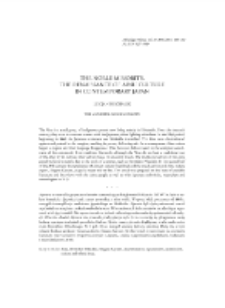- Search in all Repository
- Literature and maps
- Archeology
- Mills database
- Natural sciences
Advanced search
Advanced search
Advanced search
Advanced search
Advanced search

Object
Title: The Noble Minority. The Renaissance of Ainu Culture in ContemporaryJapan
Subtitle:
Ethnologia Polona 37 2016 (2017)
Publisher:
Institute of Archaeology and Ethnology Polish Academy of Sciences
Place of publishing:
Description:
Type of object:
Abstract:
The Ainu is a small group of indigenous people now living mainly in Hokkaido. From the sixteenth century, they were in constant contact with the Japanese, often fighting with them. In the Meji period, beginning in 1868, the Japanese settlement on Hokkaido intensified. The Ainu were discriminated against and pushed to the margins, resulting in poverty following suit. As a consequence, Ainu culture began to regress and their language disappeared. This, however, did not result in the complete detachment of the community from tradition. Currently, although the Ainu do not lead a traditional way of life, they try to cultivate their culture based on ancestral rituals. The traditional culture of the Ainu people is known mainly due to the work of scientists, such as Bronisław Piłsudski. In the second half of the 20th century the renaissance of Ainuan culture flourished and the social activist and Ainu culture expert, Shigeru Kayano, played a major role in this. This article was prepared on the basis of available literature and interviews with the Ainu people as well as with Japanese authorities, researchers and museologists in 2015
References:
Amselle J.-L. 1999. Ethnies et espaces: pour une anthropologie topologique. In J.-L. Amsel and E. M’Bokolo (ed.), Au coeur de l’ethnie: ethnie, tribalisme et État en Afrique, Paris, 11–48
Batchelor J. 1901. The Ainu and Their Folk-Lore, London
Bradley D. 2007. East and Southeast Asia. In: C. Moseley (ed.), Encyclopedia of the world’s endangered languages, London, 349–424
Izard M. 1985. Gens du pouvoir, gens de la terre: les institutions politiques de l’ancien royaume du Yatenga (Bassin de la Volta Blanche), Paris
Kayano S. 2014. Ainu tools, Biratori
Majewicz A. F. 1983. Dzieje i legendy Ajnów, Warszawa
Majewicz A. F. 1984. Ajnu. Lud, jego język i tradycja ustna, Poznań
Majewicz A. F. 1991. Dzieje i wierzenia Ajnów, Poznań
Matsushita W. and Kimi N. 1978. Ainu bunken mokuroku – wabunhen, Sapporo
no author. 2013. Together with the Ainu. History and culture, Sapporo
Piłsudski B. 1913. Trąd wśród Gilaków i Ajnów, Lud 18, 79–91
Radliński I. 1901. Przeszłość w teraźniejszości, Warszawa–Kraków
Rowthorn Ch. (ed.) 2013. Japan, Lonely Planet
Sieroszewski W. 1957. Wśród kosmatych ludzi, Warszawa
Takakura S. 1966. Vanishing Ainu of North Japan, Natural History 75 (3), 16–25
Totman C. 2009. Historia Japonii, Kraków
Zawistowicz K. 1930. Bronisław Piłsudski, Wiedza i życie 5(1), 25–40
Internet 1: https://www.ethnologue.com/language/ain, access 01.09.2016
Internet 2: https://en.wikipedia.org/wiki/Shigeru_Kayano, access 05.09.2016
Internet 3: http://www.ainu-museum.or.jp/shop/book.html, access 13.09.2016
Internet 4: http://en.wikipedia.org/wiki/Nibutani/Dam, access 13.09.2016
Internet 5: http://www.irankarapte.com/img/english.pdf, access 13.09.2016
Internet 6: http://joemonster.org/art/29123/_Usmiechniete_kobiety_Ajnu, access 12.05.2015
Relation:
Volume:
Start page:
End page:
Detailed Resource Type:
Format:
Resource Identifier:
oai:rcin.org.pl:66280 ; 0137-4079
Source:
IAiE PAN, call no. P 366 ; IAiE PAN, call no. P 367 ; IAiE PAN, call no. P 368 ; click here to follow the link
Language:
Rights:
Digitizing institution:
Institute of Archaeology and Ethnology of the Polish Academy of Sciences
Original in:
Library of the Institute of Archaeology and Ethnology of the Polish Academy of Sciences
Access:
Object collections:
- Digital Repository of Scientific Institutes > Partners' collections > Institute of Archeology and Ethnology PAS > Institute Publications
- Digital Repository of Scientific Institutes > Partners' collections > Institute of Archeology and Ethnology PAS > Institute Publications > Current Journals
- Digital Repository of Scientific Institutes > Literature > Books/Chapters
- Digital Repository of Scientific Institutes > Literature > Journals/Articles
- Digital Repository of Scientific Institutes > Partners' collections > Institute of Archeology and Ethnology PAS > Institute Publications > Current Journals > Ethnologia Polona
Last modified:
Feb 2, 2022
In our library since:
Sep 26, 2018
Number of object content downloads / hits:
688
All available object's versions:
https://rcin.org.pl./publication/85957
Show description in RDF format:
Show description in RDFa format:
Show description in OAI-PMH format:
| Edition name | Date |
|---|---|
| Buchalik, Lucjan, 2017, The Noble Minority. The Renaissance of Ainu Culture in ContemporaryJapan | Feb 2, 2022 |
Objects Similar
Kwiecińska, Magdalena
Bird, Isabella Lucy (1831–1904) Verlagsbuchhandlung von Hermann Costenoble (Jena)
Siebold, Heinrich Philipp von (1852–1908)
Batault, Georges (1887–1963)

 INSTYTUT ARCHEOLOGII I ETNOLOGII POLSKIEJ AKADEMII NAUK
INSTYTUT ARCHEOLOGII I ETNOLOGII POLSKIEJ AKADEMII NAUK
 INSTYTUT BADAŃ LITERACKICH POLSKIEJ AKADEMII NAUK
INSTYTUT BADAŃ LITERACKICH POLSKIEJ AKADEMII NAUK
 INSTYTUT BADAWCZY LEŚNICTWA
INSTYTUT BADAWCZY LEŚNICTWA
 INSTYTUT BIOLOGII DOŚWIADCZALNEJ IM. MARCELEGO NENCKIEGO POLSKIEJ AKADEMII NAUK
INSTYTUT BIOLOGII DOŚWIADCZALNEJ IM. MARCELEGO NENCKIEGO POLSKIEJ AKADEMII NAUK
 INSTYTUT BIOLOGII SSAKÓW POLSKIEJ AKADEMII NAUK
INSTYTUT BIOLOGII SSAKÓW POLSKIEJ AKADEMII NAUK
 INSTYTUT CHEMII FIZYCZNEJ PAN
INSTYTUT CHEMII FIZYCZNEJ PAN
 INSTYTUT CHEMII ORGANICZNEJ PAN
INSTYTUT CHEMII ORGANICZNEJ PAN
 INSTYTUT FILOZOFII I SOCJOLOGII PAN
INSTYTUT FILOZOFII I SOCJOLOGII PAN
 INSTYTUT GEOGRAFII I PRZESTRZENNEGO ZAGOSPODAROWANIA PAN
INSTYTUT GEOGRAFII I PRZESTRZENNEGO ZAGOSPODAROWANIA PAN
 INSTYTUT HISTORII im. TADEUSZA MANTEUFFLA POLSKIEJ AKADEMII NAUK
INSTYTUT HISTORII im. TADEUSZA MANTEUFFLA POLSKIEJ AKADEMII NAUK
 INSTYTUT JĘZYKA POLSKIEGO POLSKIEJ AKADEMII NAUK
INSTYTUT JĘZYKA POLSKIEGO POLSKIEJ AKADEMII NAUK
 INSTYTUT MATEMATYCZNY PAN
INSTYTUT MATEMATYCZNY PAN
 INSTYTUT MEDYCYNY DOŚWIADCZALNEJ I KLINICZNEJ IM.MIROSŁAWA MOSSAKOWSKIEGO POLSKIEJ AKADEMII NAUK
INSTYTUT MEDYCYNY DOŚWIADCZALNEJ I KLINICZNEJ IM.MIROSŁAWA MOSSAKOWSKIEGO POLSKIEJ AKADEMII NAUK
 INSTYTUT PODSTAWOWYCH PROBLEMÓW TECHNIKI PAN
INSTYTUT PODSTAWOWYCH PROBLEMÓW TECHNIKI PAN
 INSTYTUT SLAWISTYKI PAN
INSTYTUT SLAWISTYKI PAN
 SIEĆ BADAWCZA ŁUKASIEWICZ - INSTYTUT TECHNOLOGII MATERIAŁÓW ELEKTRONICZNYCH
SIEĆ BADAWCZA ŁUKASIEWICZ - INSTYTUT TECHNOLOGII MATERIAŁÓW ELEKTRONICZNYCH
 MUZEUM I INSTYTUT ZOOLOGII POLSKIEJ AKADEMII NAUK
MUZEUM I INSTYTUT ZOOLOGII POLSKIEJ AKADEMII NAUK
 INSTYTUT BADAŃ SYSTEMOWYCH PAN
INSTYTUT BADAŃ SYSTEMOWYCH PAN
 INSTYTUT BOTANIKI IM. WŁADYSŁAWA SZAFERA POLSKIEJ AKADEMII NAUK
INSTYTUT BOTANIKI IM. WŁADYSŁAWA SZAFERA POLSKIEJ AKADEMII NAUK




































